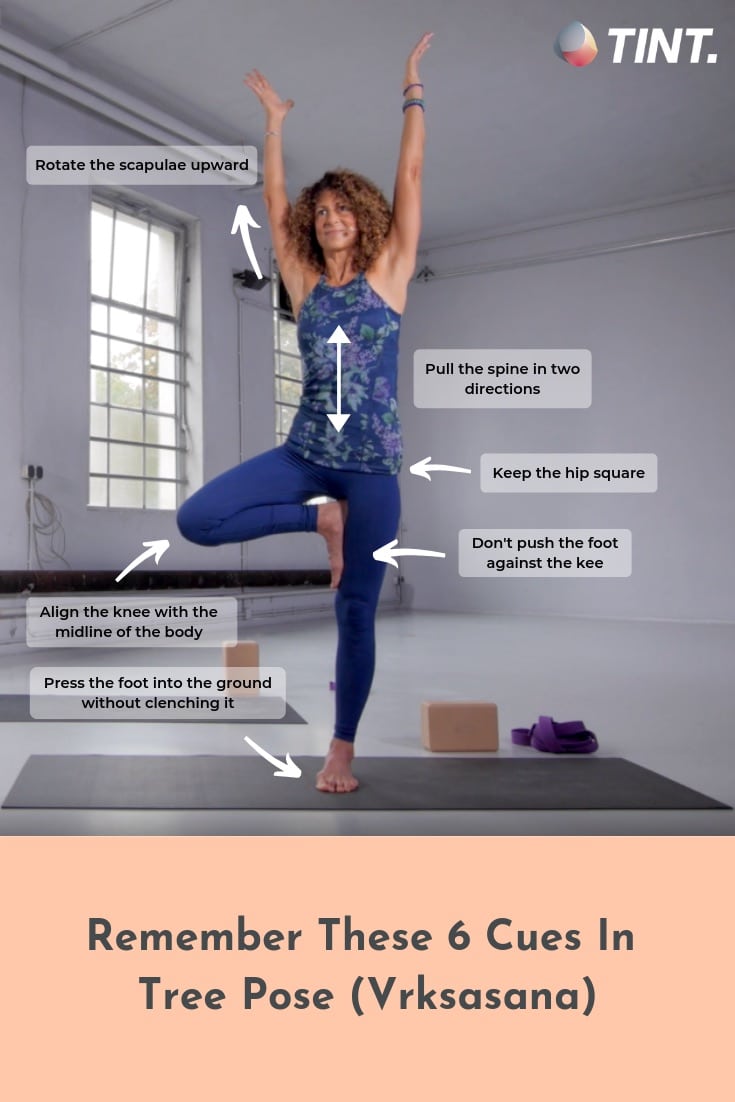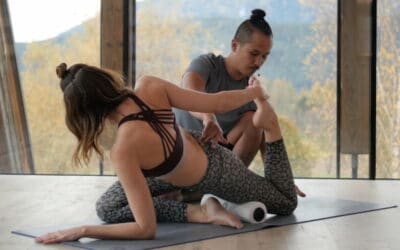Vrksasana (Tree pose) is one of the first standing balancing poses practitioners of yoga learn. However, the fact that it is a fairly easy asana doesn’t mean that it can’t be challenging. Unsteadiness and lack of focus can turn this yoga pose into a mirror of your inner state.

Tree pose is one of the first standing balancing poses you learn in yoga. Photograph by Katee Lue on unsplash.
Let this article help you get a better understanding of Tree pose:
1. How Do You Get Into Vrksasana (Tree Pose)?
- Start in Mountain pose (Tadasana) and shift your body weight into one leg, keeping the inner foot firmly on the floor. This will be your standing leg. If you feel unstable standing on one leg, you can also practice against a wall.
- Raise the other leg up and bend the knee. Then, reach down with the hand and clasp your ankle.
- Place the sole of the foot against the upper thigh of the standing leg with the toes pointing down. If you can’t bring your leg up this high, you can also place it lower down. Note, however, that you should never place it directly against the knee. Bring it above or below the knee joint instead.
- Squeeze the lifted foot into the femur bone of the standing leg and, at the same time, press the femur bone against the foot.
- Bring the bent knee into the midline.
- Let your groins move back and apart while you keep your abdomen strong.
- From inside your ribs, stretch the spine in two directions, i.e. down into the bones of your legs and up through the top of your head.
- Gaze softly at a fixed point in front of you on the floor to improve your focus and balance. This is your Drishti, i.e. your point of focus where you rest your gaze.
- Once you feel stable, you may want to take your arms up overhead.
So much for the theory. How it’s time for you to practice Tree pose, for example with Desirée Rumbaugh and Andrew Rivin in this short video. Check out their Building Blocks for a Transformational Home Practice on TINT if you want to make the most of your own practice at home. They have even created two sequences specifically aimed at standing poses, such as Vrksasana and many more.
Let Desirée Rumbaugh and Andrew Rivin help you get the correct Tree pose alignment.
2. What Is Your Body Doing In Vrksasana (Tree Pose)?
2.1. What Are the Joints Doing?
Tree pose is an asana where your spine is neutral and the pelvis is level. The shoulder is slightly flexed and adducted. The elbow is flexed and the forearm pronated. The wrist, hand and fingers are extended.
In the standing leg, there is neutral hip and knee extension while there is a lot more joint action in the lifted leg: The hip is flexed, externally rotated and abducted. The knee is flexed and the ankle is in dorsiflexion.
2.2. Which Muscles Are Engaged?
The spinal extensors and flexors help to calibrate concentric and eccentric contractions, which are required to maintain the neutral alignment of the spine.
In the standing leg, the articularis genu, the quadriceps and the hamstrings as well as the intrinsic and extrinsic muscles of the foot and lower leg are contracting concentrically to keep the knee in neutral extension and to enable you to balance on one leg.
In order to allow the pelvis to shift laterally over the standing leg, which enables you to keep your balance and your pelvis level, the gluteus medius and minimus, the piriformis, and other pelvic muscles as well as the tensor fasciae latae in the thigh contract eccentrically.
To allow the flexion of the hip in the lifted leg, the iliacus and the psoas major are in concentric contraction. So are the gluteus muscles, the piriformis and other pelvic muscles to allow for the leg to externally rotate and open to the side. The adductor magnus and minimus contract in order to press the foot into the standing leg.
The pectineus, the adductor longus and brevis, and the gracilis muscle are passively lengthening in the lifted leg.
“Like a tree, extend your roots down and blossom your arms up toward the sun. The stronger the roots, the taller the tree.”
Since the abductors of the standing leg are working eccentrically in Vrksasana (Tree pose), their weakness or tightness may result in the hip of the lifted leg tilting up. The rotator muscles of the lifted leg try to counteract this by stabilizing the pelvis. As a result, the pelvis rotates on the standing leg instead of staying level and facing forward.
Note that the action of the lifted leg with the knee moving up and out to the side is actually a quite complex muscular movement: The hip flexors are engaged to lift the knee, but since the leg is also externally rotated and abducted, the hip also needs to extend.
Since the lifted foot presses into the standing leg while the knee moves out to the side, the hip needs to adduct without flexion. This means that using the adductors to press the foot into the standing leg requires the engagement of adductor muscles that are more posterior, such as the adductor magnus. This is because the anterior adductors, e.g. the pectineus, usually are short due to sitting too much and, thus, will tilt the pelvis forward and internally rotate the lifted leg while trying to adduct the leg.
Since proper alignment is the most important thing when it comes to your yoga practice, we created a free yoga asana ebook for you, which summarizes the most important alignment cues for 10 of the most common yoga poses so you can use it as a reference guide in your yoga practice.
3. Do You Make These 6 Mistakes in Tree Pose (Vrksasana)?
Although Tree pose is a very basic asana, there are a few thing to keep in mind to make sure you’re getting the most out of this pose and don’t compromise your joints.

Find focus and balance in Tree pose. Photograph by Yayan Sopian on unsplash.
1. Letting The Hip Pop Out to The Side
One thing to work on in Tree pose is ensuring that the lifted foot pressing into your standing leg doesn’t cause the hip to pop out to the side. Your hips should remain as square as possible – just as if you still had both feet on the floor in Mountain pose.
2. Pushing The Foot Against The Knee
The next thing to keep in mind is your foot position. Avoid placing the lifted foot directly onto the knee of the standing leg. That would put your knee joint in a very unstable and vulnerable position.
3. Not Aligning The Knee
Speaking of knees, the position of the knee on the bent leg is also something to pay attention to. Make sure it doesn’t come forward too much but keep it pointing to the outside instead. Be also careful about the knee of your standing leg: Keep it soft instead of locking it, especially if you are hypermobile.
4. Clenching The Standing Foot
When it comes to the foot of the standing leg, try to spread through the toes and press the foot firmly into the floor without clenching the foot. This will allow the foot to make small movements, which help you keep your balance.
5. Not Engaging Your Muscles
Engaging the muscles of the standing leg, the hips, and glutes as well as maintaining an active core also helps you to stay balanced and stable in Tree pose. Staying relaxed and focusing on an even breath also helps you find balance in this yoga pose.
6. Neglecting Your Shoulders
Finally, it’s time to also bring your awareness to your shoulders: If you lift up your arms overhead, keep your shoulder blades tucked on your back and spread through your collarbones. To avoid shoulder impingement, externally rotate the upper arms and rotate the scapulae upward instead of drawing the shoulders away from the ears.

Practice Tree pose with Desirée Rumbaugh and Andrew Rivin’s Transformational Home Practice on TINT.
4. How Can You Adapt Vrksasana (Tree Pose) To Your Yoga Practice?
Tree pose is an asana that can easily be modified and adapted according to your needs. You can, for example, make it easier by practicing against a wall. There’s a variety of options to do this:
- Lean your buttocks against the wall to support your entire body, or
- Bring your bent knee in contact with the wall when it’s in its lifted, or
- Hold on to the wall with the hand on the standing-leg side to support yourself.
If you want to deepen this pose, experiment practicing this yoga pose with eyes closed or raising your gaze to the ceiling in order to challenge your balance. This will help you learn to balance without any reference to the outer environment.

Practice Tree pose with focus and patience. Photograph on unsplash.
Another way to make Tree pose a more challenging asana is by standing on an uneven surface such as a folded blanket or mat. This will also make it more difficult to balance. The body’s actions to counterbalance this instability strengthens the small muscles in the ankles and feet.
You can also experiment with different variations of aligning your arms:
- Stretch your arms straight up toward the ceiling, or
- Bring your arms parallel to each other with the palms facing, or
- Touch the palms together so that your arms form an inverted V.
You can also play with this pose by practicing bound tree pose variation. For this, bring the lifted foot into a Half Lotus position by placing the foot onto the groin of the standing leg. Wrap the arm of the bent-leg side behind you and try to hook your big toe with the thumb and forefingers. From here, you can fold forward into a Standing Forward Bend with a Half Bound Lotus (Ardha Baddha Padmottanasana).
If you’re looking for guidance in other common yoga poses as well, check out our free yoga asana ebook. It will give you a basic understanding of the alignment principles of some of the most common yoga poses and will make a huge difference to your yoga practice – you definitely don’t want to miss it!
5. What Are the Benefits of Vrksasana (Tree Pose)?
Tree pose is a great asana to strengthen your entire leg – from the thigh to the calve, ankle, and foot muscles. It also helps you gain strength and length in your core and spine and, thus, helps you to improve your posture.
Apart from that, Vrksasana is a pose that stretches the groins and inner thighs and opens the hips. It also provides a gentle stretch for the chest and shoulders.
The biggest benefit of this yoga asana may be its positive effect on your sense of balance by improving your focus and concentration. The steadiness in this pose helps you calm your mind and relax your central nervous system. This also helps you in almost any other physical activity. Good balance and a strong core are essential if you want to stay active and healthy.
Although Tree pose seems to be a very basic asana, it’ s a great exercise to practice patience and provides subtle reminders about your posture as well as interesting insight about your current mental state. You will notice that it is harder for you to stay balanced if you are in an uneasy state of mind.
Now it’s time for you to practice balance and focus on your yoga mat and explore your inner state with this yoga pose. You can try it in a well-rounded sequence that is especially designed for beginners. Matt Giordano provides detailed explanations and offers modifications that make this practice accessible to everyone. Have fun practicing Yoga for the Absolute Beginner on TINT!

Tree pose can easily be adapted for beginners as Matt Giordano shows in Yoga for the Absolute Beginner.





